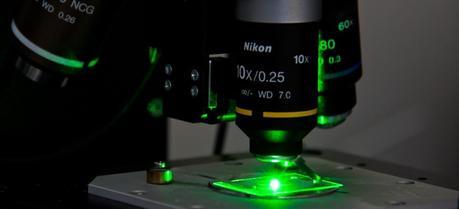 Scientists create a solar cell that can also efficiently emit light, perhaps even work as a laser. (Credit: Flickr @ Hans Splinter https://www.flickr.com/photos/archeon/)
Scientists create a solar cell that can also efficiently emit light, perhaps even work as a laser. (Credit: Flickr @ Hans Splinter https://www.flickr.com/photos/archeon/)Earlier this month we reported on a new perovskite solar cell that can also work as a light panel. Now, researchers from Professor Sir Richard Friend’s group at Cambridge’s Cavendish Laboratory—working with Snaith’s Oxford group—have demonstrated that perovskite cells can also be used to produce cheap lasers.
By sandwiching a thin layer of the lead halide perovskite between two mirrors, the team produced an optically driven laser which proves these cells “show very efficient luminescence”—with up to 70% of absorbed light re-emitted.
The researchers point to the fundamental relationship, first established by Shockley and Queisser in 1961, between the generation of electrical charges following light absorption and the process of ‘recombination’ of these charges to emit light.
Essentially, if a material is good at converting light to electricity, then it will be good at converting electricity to light. The lasing properties in these materials raise expectations for even higher solar cell efficiencies, say the Oxbridge team, which—given that perovskite cells are about to overtake commercial cells in terms of efficiency after just two years of development—is a thrilling prospect.
“This first demonstration of lasing in these cheap solution-processed semiconductors opens up a range of new applications,” said lead author Dr Felix Deschler of the Cavendish Laboratory. “Our findings demonstrate potential uses for this material in telecommunications and for light emitting devices.”
Most commercial solar cell materials need expensive processing to achieve a very low level of impurities before they show good luminescence and performance. Surprisingly these new materials work well even when very simply prepared as thin films using cheap scalable solution processing.
The researchers found that upon light absorption in the perovskite two charges (electron and hole) are formed very quickly—within 1 picosecond—but then take anywhere up to a few microseconds to recombine. This is long enough for chemical defects to have ceased the light emission in most other semiconductors, such as silicon or gallium arsenide. “These long carrier lifetimes together with exceptionally high luminescence are unprecedented in such simply prepared inorganic semiconductors,” said Dr Sam Stranks, co-author from the Oxford University team.
“We were surprised to find such high luminescence efficiency in such easily prepared materials. This has great implications for improvements in solar cell efficiency,” said Michael Price, co-author from the group in Cambridge.
Added Snaith: “This luminescent behavior is an excellent test for solar cell performance—poorer luminescence (as in amorphous silicon solar cells) reduces both the quantum efficiency (current collected) and also the cell voltage.”
Scientists say that their new paper (see footnote) sets expectations for yet higher solar cell performance from this class of perovskite semiconductors. Solar cells are being scaled up for commercial deployment by the Oxford spin-out, Oxford PV Ltd. The efficient luminescence itself may lead to other exciting applications with much broader commercial prospects—a big challenge that the Oxford and Cambridge teams have identified is to construct an electrically driven solar cell laser.
Deschler, F., Price, M., Pathak, S., Klintberg, L., Jarausch, D., Higler, R., Huettner, S., Leijtens, T., Stranks, S., Snaith, H., Atature, M., Phillips, R., & Friend, R. (2014). High Photoluminescence Efficiency and Optically-Pumped Lasing in Solution-Processed Mixed Halide Perovskite Semiconductors The Journal of Physical Chemistry Letters DOI: 10.1021/jz5005285
